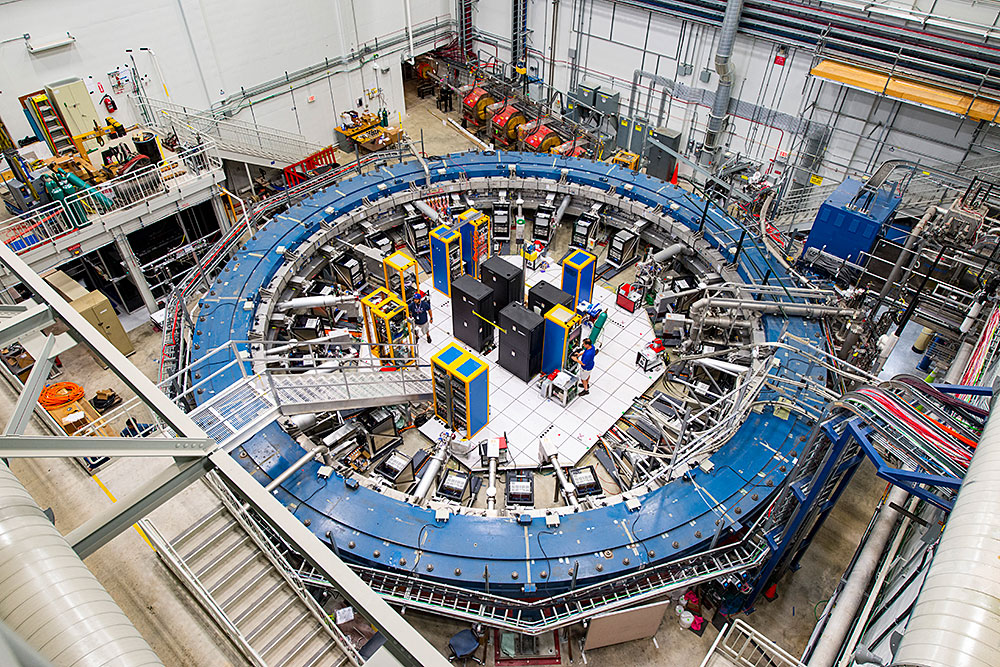Muon g-2
Context
- Recently, results of an international experiment studied a subatomic particle called the muon, do not match the predictions of the Standard Model, on which all particle physics is based, and instead reconfirm a discrepancy that had been detected in an experiment 20 years previously.
What is the Standard Model?
- The Standard Model is a rigorous theory that predicts the behaviour of the building blocks of the universe.
- It lays out the rules for six types of quarks, six leptons, the Higgs boson, three fundamental forces, and how the subatomic particles behave under the influence of electromagnetic forces.
- The muon is one of the leptons. It is similar to the electron, but 200 times larger, and much more unstable, surviving for a fraction of a second. The experiment, called Muon g–2 (g minus two), was conducted at the US Department of Energy’s Fermi National Accelerator Laboratory (Fermilab).
What was this experiment about?
- It measured a quantity relating to the muon, following up a previous experiment at Brookhaven National Laboratory, under the US Department of Energy.

- Concluded in 2001, the Brookhaven experiment came up with results that did not identically match predictions by the Standard Model.
- The experiment measured this quantity with greater accuracy. It sought to find out whether the discrepancy would persist, or whether the new results would be closer to predictions.
- As it turned out, there was a discrepancy again, although smaller.
What quantity was measured?
- It is called the g–factor, a measure that derives from the magnetic properties of the muon. Because the muon is unstable, scientists study the effect it leaves behind on its surroundings.
- Muons act as if they have a tiny internal magnet.
- In a strong magnetic field, the direction of this magnet “wobbles” — just like the axis of a spinning top. The rate at which the muon wobbles is described by the g-factor, the quantity that was measured. This value is known to be close to 2, so scientists measure the deviation from 2. Hence the name g–2.
- The g-factor can be calculated precisely using the Standard Model. In the g–2 experiment, scientists measured it with high-precision instruments. They generated muons and got them to circulate in a large magnet.
- The muons also interacted with a “quantum foam” of subatomic particles “popping in and out of existence”, as Fermilab described it.
- These interactions affect the value of the g-factor, causing the muons to wobble slightly faster or slightly slower. Just how much this deviation will be (this is called anomalous magnetic moment), too, can be calculated with the Standard Model.
- But if the quantum foam contains additional forces or particles that are not accounted for by the Standard Model, that would tweak the g-factor further.
What were the findings?
- The results, while diverging from the Standard Model prediction, strongly agree with the Brookhaven results, Fermilab said.
- The accepted theoretical values for the muon are:
g-factor: 2.00233183620-anomalous magnetic moment: 0.00116591810 - The new experimental results (combined from the Brookhaven and Fermilab results) announced on Wednesday are:
g-factor: 2.00233184122-anomalous magnetic moment: 0.00116592061.
What does this mean?
- The results from Brookhaven, and now Fermilab, hint at the existence of unknown interactions between the muon and the magnetic field interactions that could involve new particles or forces. It is, however, not the last the word in opening up the road to new physics.
- To claim a discovery, scientists require results that diverge from the Standard Model by 5 standard deviations. The combined results from Fermilab and Brookhaven diverge by 4.2 standard deviations. While this may not be enough, it is very unlikely to be a fluke — that chance is about 1 in 40,000, the Argonne National Laboratory, also under the US Department of Energy, said in a press release.
- “This is strong evidence that the muon is sensitive to something that is not in our best theory,” Renee Fatemi, a physicist at the University of Kentucky and the simulations manager for the Muon g-2 experiment, said in a statement released by Fermilab.
For Science and Technology Current Affairs: Click Here
